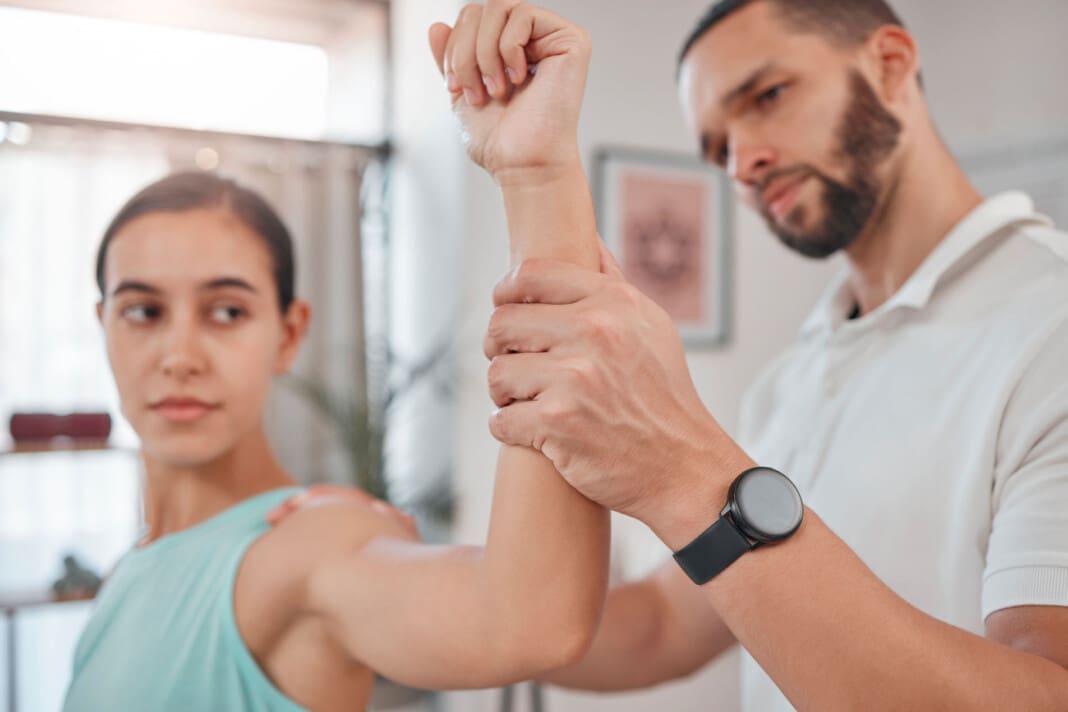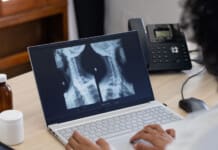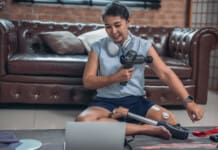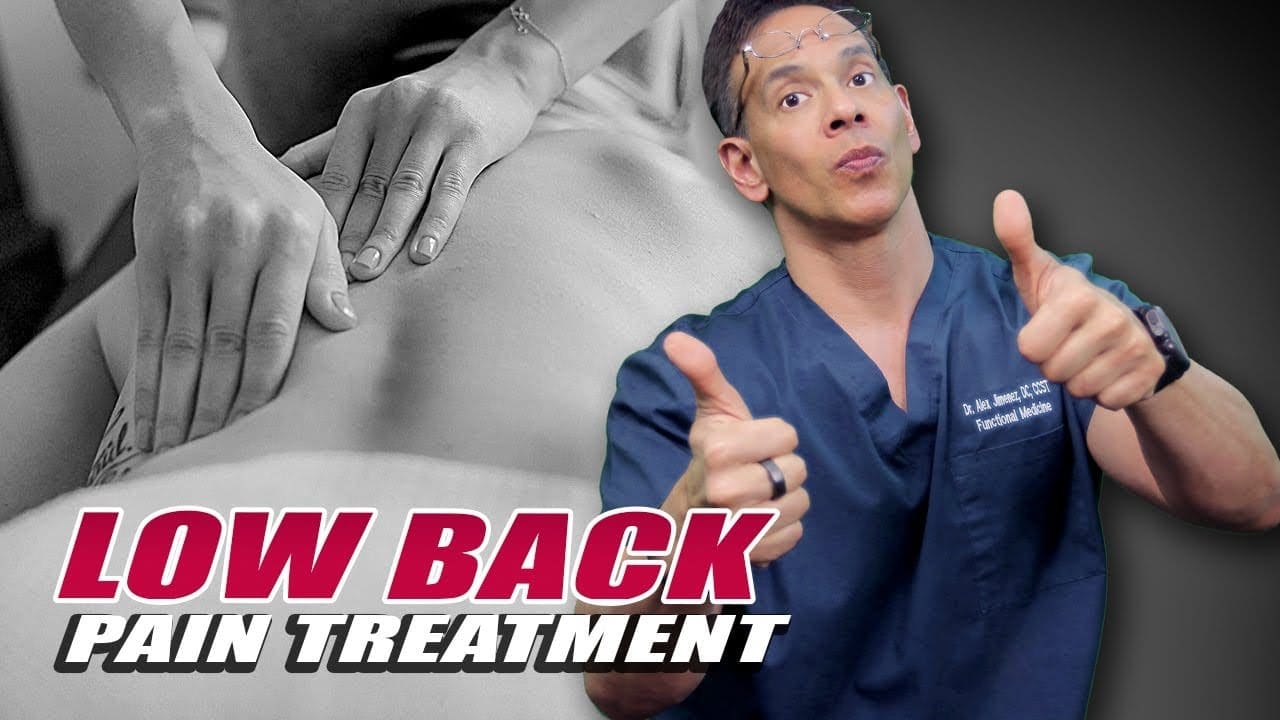Can knowing about wrist sprains—their types, symptoms, causes, and diagnoses—help develop an effective treatment program?

Table of Contents
Wrist Sprain
Wrist sprains are injuries that affect ligaments that attach bone to bone. They occur after a fall from work overuse, house tasks, during sports activities, or with other direct trauma. Symptoms of a wrist sprain include:
- Pain
- Swelling
- Bruising
- Decreased range of motion
- Weakness
- Tingling
The injury affects the ligaments and soft tissue structures connecting bone to bone. Mild wrist sprains typically heal within a few weeks; most heal without complications in six to 12 weeks. (National Health Service, 2020) However, severe injuries can require surgery, physical therapy, and months to recover fully.
Grades and Types
The three grades of sprains are graded by the severity of the injury (American Academy of Orthopaedic Surgeons, 2024)
Grade 1
- Ligaments are stretched; this is considered a mild sprain.
- The injury may heal in one to three weeks with standard care. (Mass General Brigham, 2025)
Grade 2
- Ligaments are partially torn; this is considered a moderate sprain.
- It may need a brace; healing can take three to six weeks. (Mass General Brigham, 2025)
Grade 3
- Ligaments are torn completely or have pulled away from the bone.
- Sometimes, a piece of bone comes off with it, a condition called an avulsion fracture.
- This is considered a severe sprain. It can take months to heal completely. (Mass General Brigham, 2025)
The wrist is made up of three joints (American Society for Surgery of the Hand, 2017)
Distal radioulnar
- This joint is between the two forearm bones.
- The radius on the thumb side.
- The ulna on the pinky side.
Radiocarpal
- This joint is between the radius and three small bones in the base of the hand.
- The scaphoid
- The triquetrum
- The lunate
Ulnocarpal
- This joint is between the ulna and the articular disc and cushions it from the carpal bones, the lunate, and the triquetrum.
Wrist sprains can affect any of these joints but more commonly affect the ligament between the scaphoid and lunate bone or the triangular fibrocartilage complex/TFCC on the pinky side of the wrist.
Symptoms
The primary symptom of a wrist sprain is pain, especially when moving or touching the injured area. Other symptoms can include: (National Library of Medicine, 2021) (American Academy of Orthopaedic Surgeons, 2024)
- Decreased range of motion
- Swelling
- Bruising
- Feeling instability in the wrist
- Weakness
- Numbness/tingling
- Popping sensation
- Warm skin
Causes
The common cause of wrist sprain is falling on an outstretched hand. (American Academy of Orthopaedic Surgeons, 2024) Other common causes include:
- Repetitive overuse work injuries.
- Housework and tasks.
- Sports include skateboarding, gymnastics, basketball, snowboarding, hockey, and contact sports.
Diagnosis
A healthcare provider will diagnose a wrist sprain based on symptoms and injury causes. X-rays are the first imaging to rule out fractures. Other tests can include:
- Magnetic resonance imaging – MRI
- Computed tomography – CT scan
- Arthrogram -X-rays with contrast dye
Treatment
Nonsteroidal anti-inflammatory drugs, such as Aleve, Advil, Motrin, and aspirin, can treat pain and inflammation. The severity of the wrist sprain determines whether additional treatment is needed. Sprains should initially be treated with the RICE protocol (American Academy of Orthopaedic Surgeons, 2024)
Rest
- Minimize using the injured wrist for at least two days.
- Wear a splint for support.
- Avoid sudden movements.
- Avoid placing too much pressure on the wrist.
Ice
- Cold packs are recommended several times daily for 20 minutes to decrease pain and swelling.
Compression
- Wrap the wrist with an elastic bandage or Kinesio tape to help reduce swelling.
Elevation
- To decrease swelling, use pillows to elevate the wrist as much as possible above the level of your heart.
- Grade 1 sprains usually heal with basic care within a week or two.
- Grade 2 sprains often require wearing a brace for an extended period while the ligament heals, which can take up to six weeks. (American Society for Surgery of the Hand, 2018)
- The removable brace or splint should be worn when using the arm.
- It can be taken off at rest at night and when bathing. (National Health Service, 2020)
- Individuals may need the brace for a week or more.
A healthcare provider may also recommend stretching exercises to overcome stiffness and regain mobility. (American Academy of Orthopaedic Surgeons, 2024) Physical therapy, occupational therapy, or treatment by a certified hand therapist can also reduce pain and improve range of motion and strength.
Treatment for grade 3 sprains often requires surgery. Grade 3 sprains, including avulsion fractures, often require a six-week cast for bones to heal. In some cases, the bones might also need a screw or temporary wires to hold them in the proper position. (Vannabouathong, C. et al., 2018) Severe wrist sprains may also require surgery to repair the injured ligament. If the original ligament cannot be repaired, a piece of the tendon can be used to reconstruct it. (American Society for Surgery of the Hand, 2020)
Healing Time
Mild to moderate sprains usually recover within a few weeks without long-term complications. (American Society for Surgery of the Hand, 2018) The prognosis for severe wrist sprains improves with early diagnosis and treatment. After surgery, ligaments usually heal within eight to 12 weeks but can take six to 12 months for function to return to normal. (American Academy of Orthopaedic Surgeons, 2024)
Injury Medical Chiropractic and Functional Medicine Clinic
Injury Medical Chiropractic and Functional Medicine Clinic works with primary healthcare providers and specialists to build optimal health and wellness solutions. We focus on what works for you to relieve pain, restore function, prevent injury, and help mitigate issues through adjustments that help the body realign itself. They can also work with other medical professionals to integrate a treatment plan to resolve musculoskeletal problems.
The Path to Healing Personal Injury
References
National Health Service. (2020). Advice after spraining your wrist. https://www.ruh.nhs.uk/patients/patient_information/ORT_057_Advice_after_a_wrist_sprain.pdf
American Academy of Orthopaedic Surgeons. (2024). Wrist sprains. https://orthoinfo.aaos.org/en/diseases–conditions/wrist-sprains
Mass General Brigham. (2025). Wrist sprains. https://www.massgeneralbrigham.org/en/patient-care/services-and-specialties/sports-medicine/conditions/hand-arm/wrist-sprain
American Society for Surgery of the Hand. (2017). Anatomy 101: Wrist joints. https://www.assh.org/handcare/blog/anatomy-101-wrist-joints
National Library of Medicine. (2021). Wrist injuries and disorders. Retrieved from https://medlineplus.gov/wristinjuriesanddisorders.html
American Society for Surgery of the Hand. (2018). Sprained wrist. https://www.assh.org/handcare/condition/sprained-wrist
Vannabouathong, C., Ayeni, O. R., & Bhandari, M. (2018). A Narrative Review on Avulsion Fractures of the Upper and Lower Limbs. Clinical medicine insights. Arthritis and musculoskeletal disorders, 11, 1179544118809050. https://doi.org/10.1177/1179544118809050
American Society for Surgery of the Hand. (2020). Scapholunate torn ligament. https://www.assh.org/handcare/condition/scapholunate-torn-ligament
Professional Scope of Practice *
The information herein on "How to Heal a Wrist Sprain: Tips and Techniques" is not intended to replace a one-on-one relationship with a qualified health care professional or licensed physician and is not medical advice. We encourage you to make healthcare decisions based on your research and partnership with a qualified healthcare professional.
Blog Information & Scope Discussions
Welcome to El Paso's Premier Wellness and Injury Care Clinic & Wellness Blog, where Dr. Alex Jimenez, DC, FNP-C, a Multi-State board-certified Family Practice Nurse Practitioner (FNP-BC) and Chiropractor (DC), presents insights on how our multidisciplinary team is dedicated to holistic healing and personalized care. Our practice aligns with evidence-based treatment protocols inspired by integrative medicine principles, similar to those found on this site and our family practice-based chiromed.com site, focusing on restoring health naturally for patients of all ages.
Our areas of multidisciplinary practice include Wellness & Nutrition, Chronic Pain, Personal Injury, Auto Accident Care, Work Injuries, Back Injury, Low Back Pain, Neck Pain, Migraine Headaches, Sports Injuries, Severe Sciatica, Scoliosis, Complex Herniated Discs, Fibromyalgia, Chronic Pain, Complex Injuries, Stress Management, Functional Medicine Treatments, and in-scope care protocols.
Our information scope is multidisciplinary, focusing on musculoskeletal and physical medicine, wellness, contributing etiological viscerosomatic disturbances within clinical presentations, associated somato-visceral reflex clinical dynamics, subluxation complexes, sensitive health issues, and functional medicine articles, topics, and discussions.
We provide and present clinical collaboration with specialists from various disciplines. Each specialist is governed by their professional scope of practice and their jurisdiction of licensure. We use functional health & wellness protocols to treat and support care for musculoskeletal injuries or disorders.
Our videos, posts, topics, and insights address clinical matters and issues that are directly or indirectly related to our clinical scope of practice.
Our office has made a reasonable effort to provide supportive citations and has identified relevant research studies that support our posts. We provide copies of supporting research studies upon request to regulatory boards and the public.
We understand that we cover matters that require an additional explanation of how they may assist in a particular care plan or treatment protocol; therefore, to discuss the subject matter above further, please feel free to ask Dr. Alex Jimenez, DC, APRN, FNP-BC, or contact us at 915-850-0900.
We are here to help you and your family.
Blessings
Dr. Alex Jimenez DC, MSACP, APRN, FNP-BC*, CCST, IFMCP, CFMP, ATN
email: coach@elpasofunctionalmedicine.com
Multidisciplinary Licensing & Board Certifications:
Licensed as a Doctor of Chiropractic (DC) in Texas & New Mexico*
Texas DC License #: TX5807, Verified: TX5807
New Mexico DC License #: NM-DC2182, Verified: NM-DC2182
Licensed as a Multi-State Advanced Practice Registered Nurse (APRN*) in Texas & Multistate
Multistate Compact RN License by Endorsement (42 States)
Texas APRN License #: 1191402, Verified: 1191402 *
Florida APRN License #: 11043890, Verified: APRN11043890 *
* Prescriptive Authority Authorized
ANCC FNP-BC: Board Certified Nurse Practitioner*
Compact Status: Multi-State License: Authorized to Practice in 40 States*
Graduate with Honors: ICHS: MSN-FNP (Family Nurse Practitioner Program)
Degree Granted. Master's in Family Practice MSN Diploma (Cum Laude)
Dr. Alex Jimenez, DC, APRN, FNP-BC*, CFMP, IFMCP, ATN, CCST
My Digital Business Card
RN: Registered Nurse
APRNP: Advanced Practice Registered Nurse
FNP: Family Practice Specialization
DC: Doctor of Chiropractic
CFMP: Certified Functional Medicine Provider
IFMCP: Institute of Functional Medicine
CCST: Certified Chiropractic Spinal Trauma
ATN: Advanced Translational Neutrogenomics














